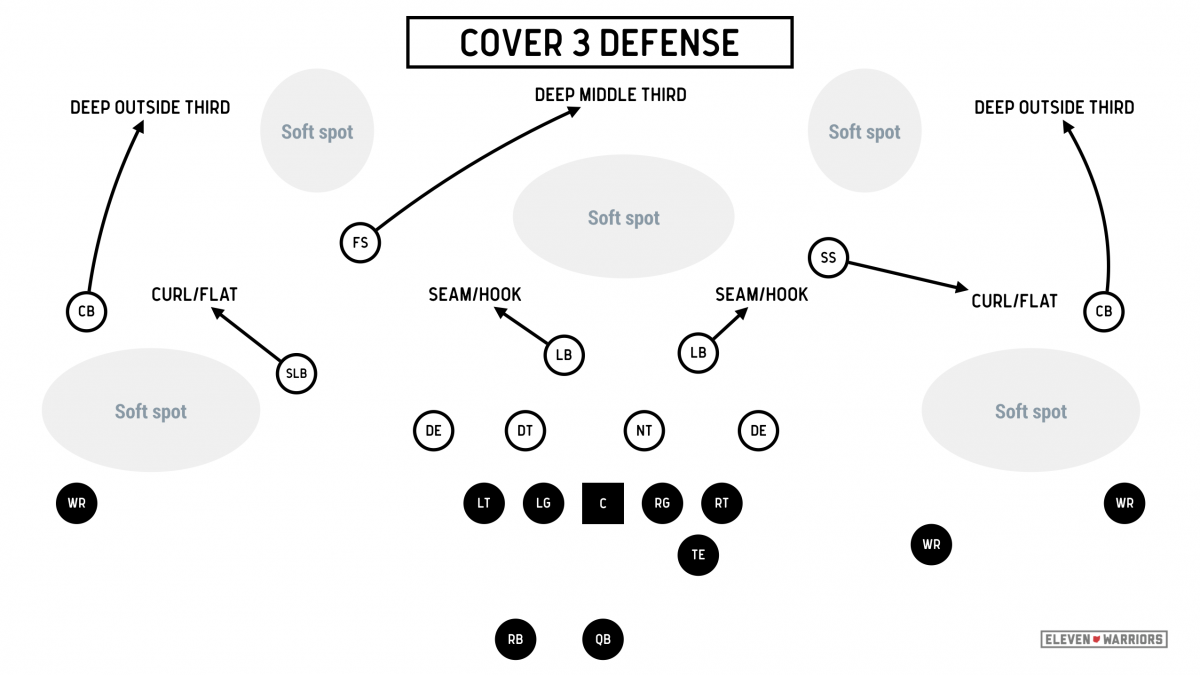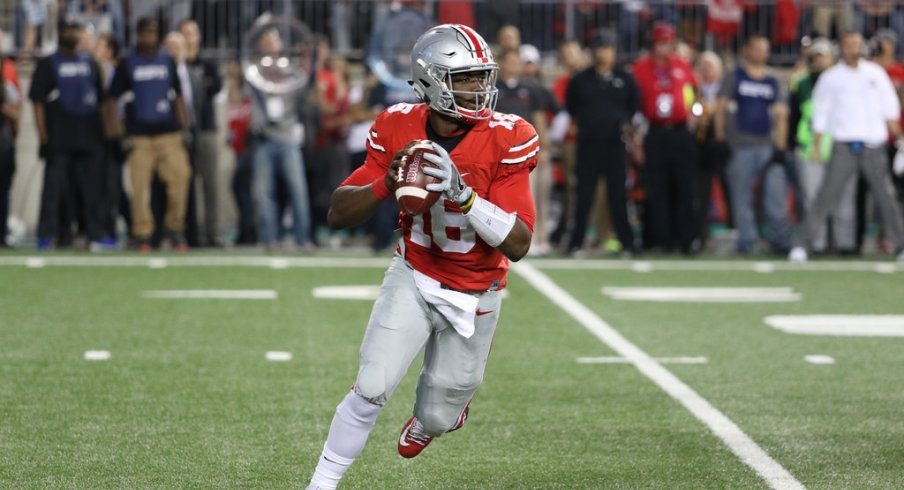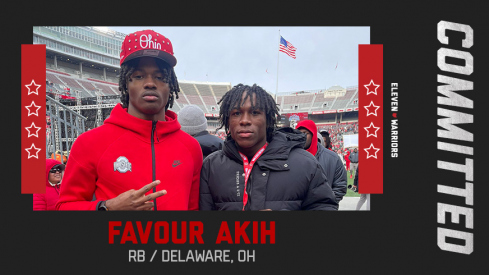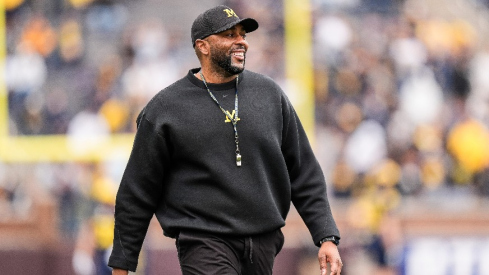In recent weeks, a pattern has emerged.
Despite completing 65 percent of his passes and not turning the ball over during the past two games, somehow quarterback J.T. Barrett has drawn the ire of some within the Ohio State fanbase as the passing game has struggled to generate big plays.
“I know it might be hard for you to understand but they’re playing off. They’re playing like 12 yards off of us,” Barrett said after last Saturday's 24-20 win against Northwestern, in which the junior completed 21 of 32 passes for 223 yards. “I think if anything, they respect our vertical passing game and try to eliminate that by having people deep. So it’s not really limited as a deep threat at receiver."
One can't blame Barrett for sounding frustrated in this statement, as few fans at home can share his view of opposing defenses thanks to TV cameras zooming in on him in the pocket. While most are busy watching him stand and deliver in the face of an oncoming pass rush, he's watching his opponent take away any deep passing routes with the use of a 'Cover 3' defense.
Though many defenses began favoring the 'Quarters' scheme to defend spread offenses over the past decade (the Buckeyes included), the 'Cover 3' scheme has proven to be effective against Urban Meyer's particular brand of the spread, which looks to run the ball first before taking shots downfield off play-action.
Instead of leaving only six defenders in the box (four linemen and two linebackers) like in a 'Quarters' look, the defense now has eight players near the line (four linemen, three linebackers, and one defensive back), all with their eyes in the backfield to help against the run. The three linebackers and a defensive back, often the strong safety, all play an underneath zone against the pass while the remaining safety and the two cornerbacks each occupy a deep third zone behind them.

The effect of keeping eight bodies near the line to help against the run has forced the Buckeyes into a more lateral running game, as the inside concepts Meyer's teams have long relied upon have been less effective over the past four weeks. Without the threat of a consistent running game, the OSU deep passing game has been virtually nonexistent, as defenses have three bodies to take away the one or two downfield routes coming their way.
After Indiana and Wisconsin found some success slowing the Buckeyes with this look earlier this month, Penn State and Northwestern followed suit by leaning almost exclusively on this coverage, regardless of down, distance, field position, or personnel. For the same reason programs like the Nittany Lions, the Iowa Hawkeyes, and for most of the 1990s and 2000s, the Buckeyes themselves, relied heavily on this scheme, recent OSU opponents have leaned on it as well, as it forces offenses to slowly work their way down the field with a string of outside runs and short passes.
While the degree to which recent opponents have relied on this coverage may have been unexpected, virtually every offensive coach in America has seen it before and has the proper counters to attack it. After slicing through the Wildcats on their first possession with a nine-play, 94-yard touchdown drive, the Buckeye offense slowed in the second quarter while likely expecting the defense to change course.
After coming out from the halftime break, however, the Buckeye offense was ready to take advantage of the tendencies shown by the Northwestern defensive staff. As with any zone coverage, there are soft spots between the areas patrolled by two players (as detailed in the diagram above), and it's up to the play-callers to attack them.
This concept, known as 'Follow-Pivot,' has long been a favorite of Meyer's, as it attacks the underneath linebackers with two routes that settle between their zones, while then running two deep crossing patterns in the soft spot directly behind them. Against Penn State, this concept was called consistently, although Barrett often settled for the underneath patterns instead of looking downfield, as he was clearly instructed to do this time around.
"Yeah, we found some things early. And they adjusted well. I think they have a very fine coaching staff," Meyer noted after the win. "It was a pretty good chess match back and forth. And I just love the way we finished it off. The fact that we had to go score a touchdown and we did.
The key to that final, game-sealing touchdown drive Meyer referred to was the way his offense attacked the outside linebackers in this zone look. One Northwestern tendency the OSU staff clearly picked up on was the way the Northwestern safety to the boundary (short side) always dropped down into underneath coverage, leaving SAM linebacker (Nate Hall, #32) to cover an extra-large zone to the wide side if the ball was on the hash marks.
The Buckeyes responded to that look by breaking a tendency of their own and placing 'X' receiver Noah Brown to the same side as the 'H' receiver, Curtis Samuel. This formation allowed the two best route-runners on the team to work against the weakest Wildcat defender in coverage.
The play-call was a simple one, adapting the 'H-option' call that is so effective with Samuel reading the zone coverage from the slot by adding an out route, knowing the cornerback to that side is dropping into a deep zone and won't be there to help on either pattern. With both tight end Marcus Baugh and running back Mike Weber staying in to block for Barrett as he rolled out to his right, the call from coordinator Ed Warinner was never meant to attack any other part of the field.
On the very next play, with the ball on the opposite hash, Warinner would continue to attack the same linebacker, Hall, in coverage to the wide side of the field. With a natural soft spot to the outside 'flat' area against 'Cover 3,' the Buckeyes had called for a number of designed swing passes to the running back, looking to use the speed of Samuel and Weber to get outside quicker than the Wildcat linebackers.
While the 34-yard completion to Hill may not pacify most fans looking for big plays in the passing game, the biggest results from that play may still be to come. The Buckeyes would punch in the touchdown two plays later, and drives like this one showed that Meyer and his staff are capable of moving the ball effectively with intermediate throws against this defensive look.
Barrett, in particular, has been excellent in this role, showing the same kind of efficiency and completion percentage that led him to the conference player-of-the-year award two seasons ago. With a staff that knows how to attack 'Cover 3' and an experienced signal-caller executing future game plans, it's only a matter of time until defenses begin to re-think their dependence on this coverage, opening up opportunities for Barrett and the Buckeyes to once again attack downfield.



